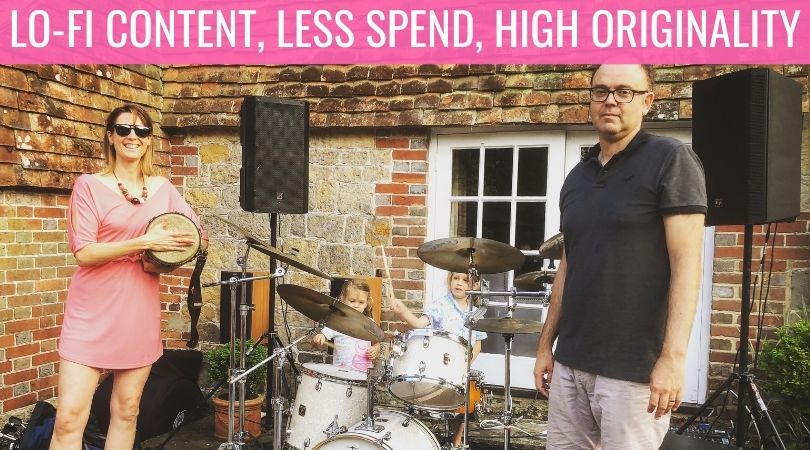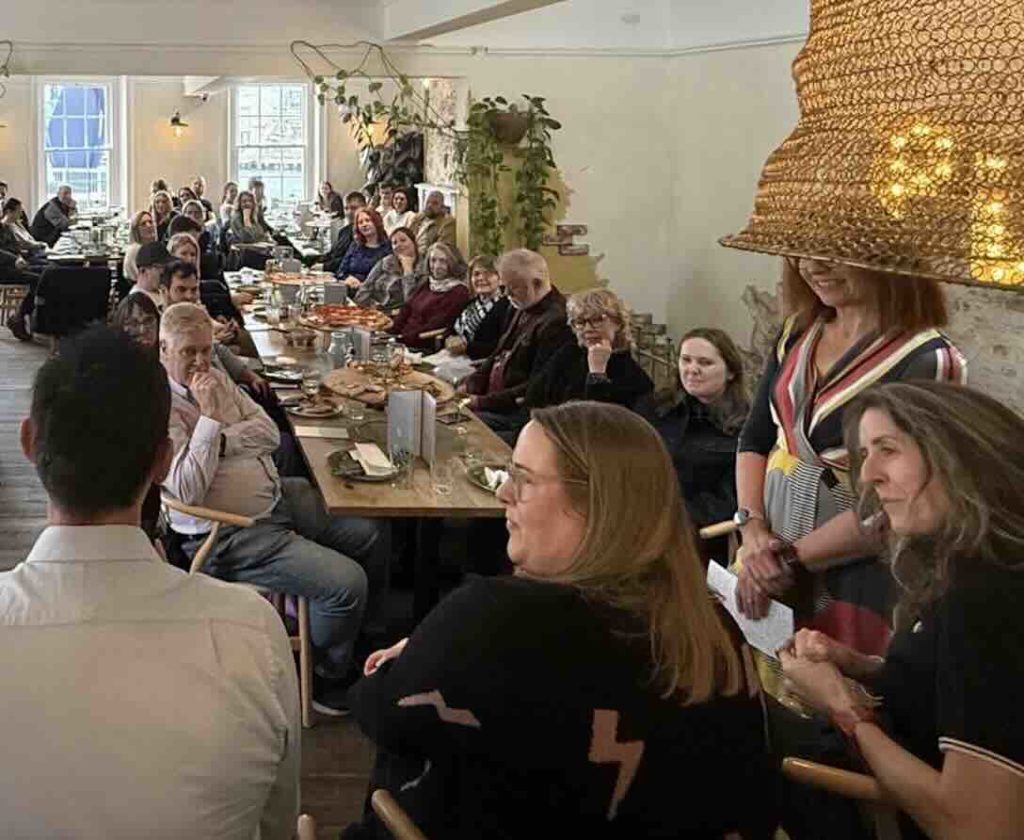Let’s learn and create together!
Book your placeLo-Fi Content Means Less Spend, More Originality

You don’t need to go into creating content as an expert – more likely than not, that role is already taken. Go the polar opposite and be all in on rawness and originality. Sell interesting, not being the same.
What makes something stand out is how it differs from the norm (and yet stays true to the overall message you want to share).
A lo-fi approach is about being ‘low quality’ on purpose, not with what you’re saying, but in ‘how’ it gets presented. The idea of lo-fi B2B content takes its inspiration from a musical movement with which we can draw many parallels.
So taking the musical genre as a starting point and showing how it can work for your business, here goes…
What Is Lo-Fi?
Lo-Fi is a type of music that champions a DIY ethos or, according to the Cambridge Dictionary, “the production by electrical equipment of poor-quality sound that has noises that should not be there.”
If high-fidelity music is all about the production value and quality, lo-fi is the opposite side of the spectrum that embodies low production value, on purpose. According to Music Gateway, “Instruments used are usually considered to have imperfections. They are of low recording and production quality compared to other instruments. However, artists’ deliberate use of such instruments and elements have created a new sound.”
To explore some lo-fi, here are some Spotify playlists, if you are an indie kid, click here, if you want your beats click here. Lo-fi is an industry in itself that dates back to punk.
It’s that rough and ready, distorted sound that people love. Hands up, the 90s was my decade and lo-fi is my bag.
Sharing Recent Examples With You
If lo-fi celebrates low production values and has a sense of rawness about it, then we should be in. I’ve been testing this out further in 2021 and it’s working. Let me share this with you:
The glue holding everything together should be the overall message you want to communicate. Don’t get sidetracked from it. Even though your presentation may be lo-fi, you can still get a serious point across. All you’re doing is adapting the way you deliver.
In the build-up to a You Are The Media event I use LinkedIn as the main platform on which to promote what is lined up (i.e. no paid advertising – what I want to highlight here is that there is a way of achieving reach without financial outlay).
In 2020 this was in the form of text-only posts. Here is an example from our event with Mark Ritson, here is how it looked here is how it looked. This post received just over 900 views.

I then decided to step away from the mainstream, namely text-based posts, and started to use video a lot more alongside the event schedule.
2021 has been the year I ramped up this world of lo-fi, investing in equipment for my phone and a lapel microphone (this is what I use). Editing (just the start and end) is also done on my phone.
The point I want to get across is that the trade-off in production value has heightened the originality and immediacy of the content. More often than not it has involved homeschooling and bringing my two daughters into the act (for them I call it a mix of drama lessons and computing!). To promote a recent YATM Online, I used my home as the setting and brought the family in, click to have a look. The result was nearly six times more people viewing the video post (nearly 5,500 people vs 900 people) as compared to the text-only post.

This lo-fi, DIY approach has already taken many guises, from promoting You Are The Media Learning with our take on the Handforth Parish Council meeting, click here to watch click here to the bad singing at the YATM Christmas event with which we closed 2020.
Bring Some Lo-Fi Pointers In
To many people, this approach may seem like you’re just letting standards slip and allowing yourself to look foolish. But, sharing work that is rough around the edges doesn’t mean that you publish an article littered with errors and bad spelling or post audio clips for their poor sound quality.
It’s a decision to deliver content in a DIY way – your own way – making use of what’s uniquely yours, and what’s to hand, and that’s what helps differentiate you from everyone else.
Most importantly, apply this sort of thinking:
LOW COST = HIGH CREATIVITY
LOW QUALITY = HIGH ORIGINALITY
To get to a place of producing lo-fi work, you have to build trust first. This comes from putting your stamp on your marketplace. The longer you stay in the arena, the more opportunity there will be to play (read this article on producing anti content).
As your audience starts to grow, hopefully your confidence will too – you’ll worry less and find it easier to step out of your comfort zone. For me, I would have previously worried about people judging me negatively or walking away. Over time, I have become ok with taking that risk and if people think all I’m being is foolish, then we were probably never meant to be anyway.
Let me put your mind at rest, the people who know, trust and like you, won’t call you out.
Another point that’s important to make here is, that as we come out of the pandemic and people battle to be seen and heard, doing more of what makes you unique and less of what everyone else does and expects, will only work in your favour.
What Does This Mean For Businesses That Go Lo-Fi?
Before we step into some pointers for you to think about, I just want to highlight how a lo-fi approach has its place in the business world.
The biggest reason for me is that people get to see the real human being behind what you do and who you are. Again, high creativity, high originality.
Whilst other, or larger businesses are spending their budgets on higher-production-value output, your lo-fi approach gives people a way to see the real you. It also enables you to work fast. For instance, I had the initial idea for doing a ‘parish council’ video on Friday evening. I reached out to Fleur Cook and Matt King on WhatsApp on Monday, and we recorded it at 5pm that day and started sharing it from 6pm. If we’d taken our time and recorded it a week or so later, the news story that inspired our video would have been out of the public consciousness and we would have missed the boat.
What is seen as creative one week, can become irrelevant the next. Putting the emphasis on speed of delivery can work to your advantage.
What Does It Mean For You?
How can you introduce a lo-fi approach into your own work? Here are some pointers to help with direction:
Be resourceful, recognise that opportunity is all around and make use of it.
For instance, the haphazard nature of homeschooling alongside working makes videos featuring family life relevant and timely. If these were to be shared once the kids were all back at school that ‘moment in time’ humour would be lost.
Create work that looks rough around the edges on purpose.
There is no need to apologise or make excuses for things that don’t look immaculate. Always remember it is more important to deliver on individuality than formulaic appearance.
It might not work, that’s ok.
The only way you are going to know if something will work is when you share it. If you don’t share, it can’t count! You have to get comfortable with this notion.
A low budget is not a drawback.
I wanted to get this point in again as it’s enthusiasm, creativity and originality that builds your asset, not the investment made in the post-production effort. Costly may mean slicker but it does not automatically mean better.
Accept that nothing (and no one is perfect).
For people who share their point of view on camera, something approaching perfection can only come with a huge amount of practice and effort. For instance, to get to this (this is the You Are The Media about us video) you have to go through this (the video of the mistakes and imperfections and in my eyes better). The second we acknowledge that we were never meant to be bona-fide presenters, writers, hosts and producers, the easier it all becomes.
Spend less time on the execution.
If you have the main message you want to get across sorted (in my case, letting people know about YATM events), then taking the lo-fi approach gives you freedom to just delve into the idea, produce it and then share it. Doing these short videos promoting events has been hugely enjoyable and I hope the fun of making them doesn’t stop. The investment should be in the idea, not the preparing and processing around it.
If you don’t do it, no one else will.
Always remember that the ability to act quickly, produce, record and share is not down to anyone else. You don’t need permission or approval, more the ability to find the seed of an idea, act on it and see it through. The short videos that I’ve shared so far in 2021 started out as just that – thoughts.
Let’s Round-Up
Be honest and true in the work you produce as that is where you’ll find your own particular brand of originality.
Inject something unexpected, unusual or surprising into your work. For instance, if a lot of the work you share is text-based, find ways to command more attention by bringing in video or audio elements. They may be low budget, but if they’re packed with energy and creativity, you could be onto winners.
Our work is never going to be faultless and our audiences will never be perfect either. It can be said that imperfections heighten the power of the messages we want to get across. Very much like the music that came from the lo-fi scene, it’s the raw edge and unexpectedness that helps you reach more people than you could have ever imagined.
COME & JOIN US FOR THE YOU ARE THE MEDIA MONTH OF LEARNING & YOU TO BUILD YOUR BACK CATALOGUE.
Podcast: Play in new window | Download
Build Your Community
A brand new programme from Mark Masters for businesses wanting to make that next growth step.
Find out moreYATM Club
Where non-conformist business owners come to work, learn and make friends. Click here

